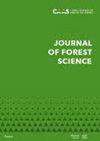Effect of LED lights on the in vitro growth of Pinus pseudostrobus Lindl., plants
IF 1.1
Q3 FORESTRY
引用次数: 1
Abstract
Pinus pseudostrobus Lindl. is a species endemic to Mexico and is widely used in reforestation programmes, as it is highly adapted to poor, shallow, limestone soils and has high commercial importance. However, it is necessary to preserve this genetic material since it is in trouble due to high rates of deforestation, land use change, and forest fires, so it is necessary to have effective strategies to obtain good quality seedlings. Due to the properties of LED (light emitting diode) lamps used for illumination in the production of in vitro plants, the effects of two different lighting systems (LED and fluorescent) on an in vitro culture were analysed for the morphological characteristics of the growth and photosynthetic pigment content in P. pseudostrobus seedlings. The length and root size of the seedlings were affected by the type of illumination, where a red LED light was the most effective at 30 days of evaluation. However, a blue LED light was equally effective as a red LED light at 60 days of seedling development. On the other hand, the fluorescent light was better in terms of the number of needles in the first stage, but we found the blue LED light to be better in the second stage. For the photosynthetic pigment content, the highest values were found with the blue LED light. The results showed that the LED lighting system favours the growth, development, and photosynthetic pigment content of the species under study.LED灯对假松离体生长的影响。,植物
伪松是墨西哥特有的物种,广泛用于重新造林方案,因为它高度适应贫瘠、浅层的石灰石土壤,具有很高的商业价值。然而,由于森林砍伐率高,土地利用变化和森林火灾,这种遗传物质处于困境,因此有必要保护这种遗传物质,因此有必要制定有效的策略来获得优质的幼苗。利用LED(发光二极管)灯在离体植物生产中的照明特性,分析了两种不同的照明系统(LED和荧光)对离体培养假石竹幼苗生长形态特征和光合色素含量的影响。幼苗的长度和根系大小受光照类型的影响,其中红色LED灯在30天的评估中最有效。然而,在幼苗发育的第60天,蓝色LED灯和红色LED灯同样有效。另一方面,荧光灯在第一阶段的针数上更好,但我们发现蓝色LED灯在第二阶段更好。光合色素含量以蓝色LED光处理最高。结果表明,LED照明系统有利于所研究物种的生长发育和光合色素含量。
本文章由计算机程序翻译,如有差异,请以英文原文为准。
求助全文
约1分钟内获得全文
求助全文
来源期刊

Journal of forest science
Forestry-
CiteScore
2.30
自引率
9.10%
发文量
48
审稿时长
6 weeks
期刊介绍:
Original results of basic and applied research from all fields of forestry related to European forest ecosystems and their functions including those in the landscape and wood production chain are published in original scientific papers, short communications and review articles. Papers are published in English
 求助内容:
求助内容: 应助结果提醒方式:
应助结果提醒方式:


